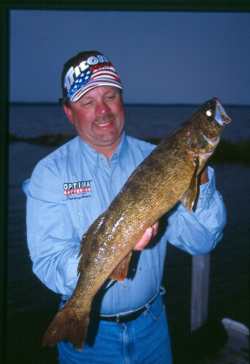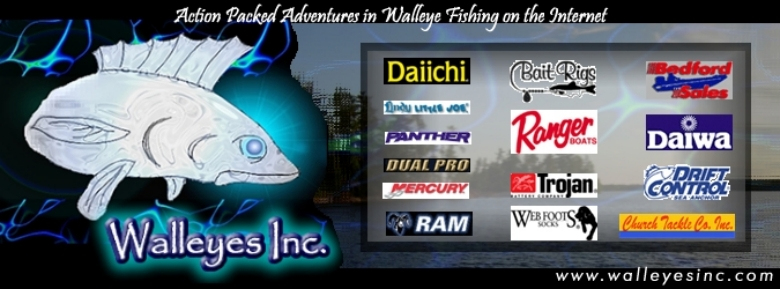| Editor's note: John Kolinski is the 2002 Professional Walleye
Trail Angler of the Year, last year's Illinois River RCL winner
and a 15-time championship qualifier on the PWT, RCL and Masters
Walleye Circuit. His articles can be read in numerous Midwestern
outdoor publications and at several web sites. Kolinski is sponsored
by Triton Boats, Mercury Motors, Lowrance Electronics, Normark/Storm
Lures, MinnKota, Lindy Legendary Tackle, Tempress Rod Holders,
Off-Shore Planer Boards, Berkley Trilene, Optima Batteries,
Panther Marine and Headlight Lures |
In all my years of fishing, I have yet to see an angler pull
a copy of "Criminal Masterminds" from the glove box
of their boat.
Yet, there is no question that late-summer walleye anglers are
a devious, even underhanded, lot. We have to be. It's tough
to put one over on a fish that has seen every kind of lure that
swims, knows how to use the cover of darkness, has found safety
and security in small groups, knows every nook and cranny of
the neighborhood and understands that patience and impeccable
timing usually pay off with a safe and tasty meal.
Catching these September bandits means thinking on their terms.
When their life revolves around trying to sneak around your
defenses and rob you of your angling fortune, it's time to play
dirty.
Desperate times call for desperate measures. Here are five proven
steps to catching a late-summer walleye red-finned, if you will:
Think like the perpetrator
The more you know about your prey, the better your chances of
luring it into a mistake.
We know that because water temperatures are still near their
warmest levels of the year, a walleye's metabolism is working
overtime. Cooling evening temperatures also tell most species
of fish that the hard times of winter aren't far off.
It all adds up to walleyes with a need to feed. They must eat
in either larger quantities, more frequently, or both.
We also know that, as anglers, we are competing with a smorgasboard
of food that exists in the aquatic world by late summer. From
crawlers, leeches, crayfish, bugs and frogs to shiners, chubs,
minnows, shad and other fish species, there is no shortage of
available forage, much of which has spent the summer growing
to an edible size.
We know that the comfort zone of late-summer walleyes relates
directly to the oxygen content in the water. That means the
perpetrator could be planning its next heist anywhere from a
deep-water ledge or rockpile to a wind-blown point or shoreline.
We know, too, that big walleyes in particular tend to prefer
smaller numbers in their gangs as the year wears on. In many
bodies of water, they lay claim to a small piece of turf while
their younger brethren heedlessly roam the underwater world
in larger groups.
Conduct a stakeout
Any crooked walleye worth his or her salt has studied every
inch of its immediate environment. They know where they are
comfortable, they know their best point of ambush, and they
know where the escape routes exist.
As anglers, we can close in on these subjects by taking a similar
approach. Fortunately, modern electronics give us the means
to accomplish this.
While there are times when searching the shallows will jail
a good catch of walleyes, most of my late-summer fishing is
done in clear water on bright days with little wind. That's
when I focus on structure such as rockpiles, breaklines, sand
bars and points.
I trust my Lowrance 111HD to show me exactly what is beneath
my boat. The sonar function shows me exactly what size and numbers
of fish are present, and where they are located in the water
column, which is often a strong indication of what species of
fish they are. If I'm not marking baitfish or what look like
walleyes, I move to another location.
Once I'm confident there are walleyes in the area, the 111HD's
global positioning feature with pre-loaded mapping shows me
exactly what those fish are relating to, whether it's a rocky
bottom, a mud bottom, vegetation, a dropoff or the slightest
change in depth. I can tell where thermoclines exist, and I
can pinpoint those always important transitions in bottom content,
along with the elbows, saddles and cups that so often seem to
hold walleyes.
On the rare occasions when there is heavy cloud cover or a good
chop on the water, I stake out likely feeding areas such as
flats, sandbars or wind-blown points that are adjacent to deep
water.
Walleyes will take advantage of these conditions because they
feel safe, and they'll move up into the shallows to feed several
times during the day. If you are there when they get active,
you're in for some fast action.
A lot of times, this approach rounds up a walleye or two, then
the suspects scatter. That tells me that only a few fish at
a time are moving in from deeper water and usually, if I'm patient,
there will be periodic flurries of activity. If not, simply
slide back and raid the deeper water nearby.
Wear a disguise
Since walleyes are always trying to hide from us or simply blend
in with their deep-water surroundings, it follows that we'll
have a better chance to catch them if they don't know that we're
looking for them.
That means offering them something that isn't what it appears
to be, and that usually means crankbaits.
Normark Shad Raps and Storm Thundercranks are two staples in
my trolling arsenal because they imitate a variety of forage
species. They offer a realistic profile and alluring vibration,
in addition to their visual appeal.
Just as important, these lures can be trolled at high speeds,
and that is another key to catching late-summer fish. Walleyes
have seen a lot of crankbaits by September, and if you give
them too long a look at them, the mature fish are reluctant
to commit.
I crank my Mercury 9.9 kicker up to 2 1/2 or even 3 1/2 mph
and try to solicit reaction strikes. The bait is going past
the walleye at a much faster speed, and it is therefore forced
to act quickly to a bait that catches its eye.
Another reason I like Shad Raps and Thundercranks is their performance
at higher speeds. With a little tuning, which is done by making
slight adjustments to the eye where your snap swivel attaches
to the lure, you can usually get them running perfectly straight
at whatever speed you want to troll.
Sometimes, it takes a couple of adjustments. After each one,
hold the lure in the water alongside the boat, then pull it
rapidly forward. If it kicks out to either side, keep tuning
until you can no longer get it to run astray.
Bait and switch
Another devious trick that can bust big walleyes is to show
them one thing, then give them another.
This is a method I like to use when I've located fish, but can't
get them to bite crankbaits. Then I'll switch over to live bait,
slow down and dangle a hyperactive redtail chub, a willow cat,
a leech or a crawler in their face.
It's like feeding somebody who's on the lamb. If they've been
living on a steady diet of bologna and a steak presents itself,
they probably won't be able to resist.
If I can't get a particular fish to bite after a few minutes,
I move on to the next one and work on it for awhile, then return
to round up the rest of the gang later.
Another way to execute a bait and switch is to rig a crankbait
in tandem with live bait.
You can do this several ways. In depths of 8 to 12 feet, I use
a deep-diving Shad Rap like a No. 8 or No. 9 with a bait-tipped
floater or plain hook snelled on 3-4 feet of Yozuri Hybrid line
and tied to the rear eye of the crank where the split ring is
attached.
In states that allow only one hook per line, simply remove the
hooks from the crankbait. It still serves as an attractor, and
most of the time the fish are going to be more interested in
the real thing that's coming along directly behind the crank.
 |
Create a diversion
There are a number of excellent ways to confuse walleyes
that think they've got everything figured out.
Once of my favorites is to tempt them with something they
don't see every day. In bodies of water that don't have
redtail populations, that's a delicacy walleyes often
can't refuse. In other bodies of water, a spot tail shiner
might be the answer.
Combo rigs are another method of creating a diversion,
as are bottom bouncers and spinner rigs.
Bouncers stir up the bottom and while that may send up
a red flag to a walleye when it first passes by, fish
don't have much memory retention and by the time that
leech or chub comes along eight or nine feet later, they
move on it. |
Spinners offer sensory qualities like sound, vibration and flash.
And again, while that in itself might not impress a walleye,
that juicy crawler coming along behind it might.
Late-summer walleyes don't play fair, and neither do the anglers
who are consistently able to catch them. Know your prey, study
its habits and habitat and pull out your dirtiest tricks.
Don't get robbed of your chance to catch these crafty fish.
Turn your devious mind loose and put an end to those frustrating
September walleye capers.
|
|
Please Check Out these links
below to our site Sponsors
|
|

